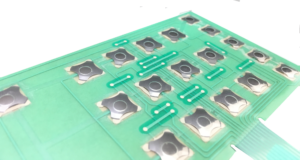Exploring the Manufacturing Process of High-Quality Membrane Switches
Exploring the Manufacturing Process of High-Quality Membrane Switches
Blog Article
Membrane Switch Technology: The Secret to Dependable and Affordable User Interfaces
Membrane layer switch modern technology has emerged as a critical part in the style of user interfaces, giving both integrity and cost-effectiveness throughout a diverse range of applications. As we explore the diverse benefits of membrane layer switches, their capacity for innovation raises concerns about future applications and advancing patterns.
Understanding Membrane Change Modern Technology
Membrane switch innovation is an extensively made use of user interface option in different electronic tools, providing a smooth blend of capability and style. This technology incorporates multiple layers of materials, generally including a visuals overlay, spacer layer, and a circuit layer. The graphic overlay displays the user interface elements, while the spacer layer divides the circuit layer from the overlay until a customer turns on a switch.
When pressure is applied to the overlay, the circuit layer finishes the electric circuit, sending a signal to the gadget. This system enables different setups, consisting of tactile feedback and backlighting options, boosting user communication. Membrane buttons are usually made making use of long lasting products such as polyester or polycarbonate, making certain longevity and resistance to ecological factors like moisture and dirt.
The convenience of membrane layer changes allows their application in varied sectors, consisting of medical tools, consumer electronic devices, and industrial controls. Their compact style enables assimilation into space-constrained atmospheres, giving an effective user interface without jeopardizing aesthetic allure. Comprehending the details of membrane layer switch innovation is necessary for suppliers and developers looking for to develop trustworthy and reliable human-machine interfaces.
Trick Advantages of Membrane Layer Switches
While various user interface remedies exist, membrane layer switches offer distinctive benefits that make them a preferred option in various applications. One of the main advantages is their resilience; membrane switches are designed to hold up against severe ecological problems, consisting of dampness, dirt, and temperature level changes, making certain long-lasting performance. This durability considerably decreases the need for constant substitutes, therefore reducing total maintenance expenses.

Furthermore, membrane buttons are lightweight and compact, making them appropriate for applications where room is limited. Their inconspicuous layout adds to a smooth look without jeopardizing performance.
Cost-effectiveness is likewise a notable advantage, as the production procedure for membrane switches has a tendency to be less expensive compared to conventional mechanical buttons. This affordability, integrated with their reliability and convenience of installment, positions membrane changes as a functional service for a vast variety of markets looking for effective and efficient interface.
Applications Across Different Industries
Just how do membrane buttons adjust to the anonymous diverse demands of different industries? Membrane layer button modern technology is progressively recognized for its flexibility, making it suitable for a broad variety of applications across several sectors.
In customer electronic devices, membrane layer switches supply a compact option for remote controls and home appliances, boosting customer experience with intuitive style. Additionally, the industrial sector leverages membrane switches for machinery control panels, profiting from their resistance to rough environments, such as moisture and dirt.
Armed forces and aerospace applications also utilize membrane layer switches for their reliability and capacity to hold up against extreme problems, making sure functional performance in critical circumstances. The food and beverage industry embraces these buttons for automated systems, where sanitation and ease of procedure are paramount (membrane switch). Inevitably, membrane layer switches are customized to meet the special demands of each market, proving their crucial duty in contemporary innovation interfaces
Design and Personalization Choices

In the realm of membrane button technology, layout and modification alternatives play an essential role in enhancing functionality and individual interaction. These switches can be tailored to fulfill particular operational needs and aesthetic preferences, making them versatile components in numerous applications.
Among the browse this site main customization choices is the format of the switch itself, which can be designed to accommodate special interface and ergonomic considerations. By readjusting the form, size, and plan of switches, producers can create user-friendly styles that help with ease of usage. Additionally, the incorporation of various colors and visuals overlays enables for branding and improved exposure, guaranteeing that customers can rapidly recognize features.
Furthermore, membrane layer buttons can be engineered with different tactile feedback systems, such as elevated buttons or audible clicks, to improve the individual experience. Different materials can likewise be chosen for durability and ecological resistance, addressing elements such as dampness, temperature variations, and chemical exposure.
Inevitably, the substantial style and customization alternatives offered in membrane button technology empower services to produce customized services that not only fulfill useful demands however also align with their branding and functional demands.

Future Trends in Membrane Layer Buttons
As membrane layer switch technology remains to evolve, future trends are progressively focused on enhancing individual experience and incorporating advanced functionalities. One considerable pattern is the assimilation of touch-sensitive and capacitive technologies right into standard membrane layer buttons. This growth enables even more intuitive interface, giving tactile feedback while keeping a smooth design.
An additional arising trend is the use of eco-friendly products, driven by the growing need for sustainable production techniques. Producers are seeking to reduce their carbon impact by using recyclable substratums and low-impact inks, aligning with international sustainability goals.
In addition, the surge of the Internet of Points (IoT) is motivating the consolidation of clever attributes into membrane switches. Enhanced connectivity choices will certainly enable gadgets to interact with each other, allowing for seamless combination into more comprehensive systems.
Furthermore, advancements in printing modern technologies, such as digital printing, are allowing for greater design flexibility and personalization. This enables manufacturers to create anonymous detailed designs and dynamic shades cost-effectively.

Verdict
In verdict, membrane layer button innovation represents an important development in individual interface layout, providing significant advantages in sturdiness, customization, and cost-effectiveness. As developments continue to arise, specifically in touch-sensitive interfaces and sustainable products, the potential for membrane layer changes to boost individual experience and capability stays promising.
Report this page